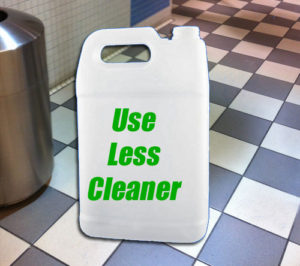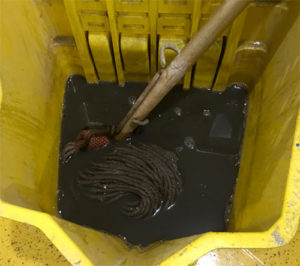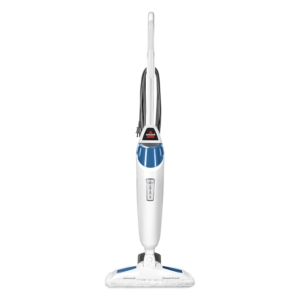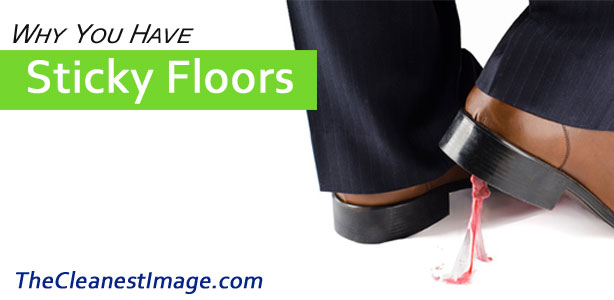If you have ever wondered how to clean sticky floors, you know it can be a very frustrating issue. It can seem like there is no answer to the problem. You mop and scrub away only to have the floor end up stickier than when you started. Trust me, I’ve been there.
Having someone walk across a floor that you have spent a lot of time cleaning, only to hear their shoes make that sound. That ‘tape being pulled away from the roll’ sound that is cleaning the soles of everyone’s shoes. Well, I have good news for you. A sticky floor can be fixed. And it really isn’t that difficult once you get to the bottom of the cause.
Why Floors Are Sticky After Mopping
There are 2 core reasons that a floor may be sticky. It is either caused by use or by cleaning. “Use” can be anything from something that has been tracked in, or spilled on the floor. In short, it is not caused by cleaning.
If you have ever had a soft drink spilled on a floor, you know that the residue left behind is very difficult to remove by simply mopping. You have to mop and mop, over and over to get it cleaned up. And even then, it may not solve the problem.
But if you stick with it, you will eventually get the residue removed. It just requires multiple cleanings. If you know that the stickiness is caused by floor use, then the solution is simply more cleaning.
The second, and in my experience, most common reason for a sticky floor is cleaning. Yes, the same cleaning you do to control what gets spilled and tracked onto the floor. (This is why it is so common)
Cleaning can easily solve a sticky floor problem, but it has to be done correctly. With the correct cleaning products and tools.
How To Clean Sticky Floors
Believe it or not, your cleaning efforts may be the cause of your sticky floor. That can be a difficult thing to hear. You have spent a lot of time trying to get the floor clean, but there are 3 key reasons that that can play a part in cleaning causing a sticky floor. Too much or too strong of a cleaning solution, the wrong cleaning solution and dirty water. It can even be a combination of all 3!
Too Much Cleaning Chemical
Using too much cleaning chemical is often the main reason that floors become sticky. The soapy residue dries and is left behind. Even the mildest of cleaning solutions, if used in a heavy dilution, will cause floors to become sticky.
A common mindset is that more cleaning chemical makes a cleaner floor. But this is not the case. Ever. Floor cleaning chemicals are designed to be effective at a specific dilution. Use too much and it can be a sticky floor disaster.
One way to reduce the amount of cleaning chemical you use is to have a dilution station in a mop closet. These dilute the chemicals for you. In many cases, floor cleaners are super concentrated and can be difficult to measure the correct amounts.
With a dilution station, all you have to do is push a button to mix the water and cleaning chemical. This removes the guess work and can save you a lot of money.
The Wrong Cleaning Chemical

Sometimes sticky floors can be caused by using the wrong cleaning chemical to remove soils from the floor. An example can be found in the section above. If you have, in fact used too much cleaning chemical on the floor, the residue that is left behind is the cleaning chemical. Even by using the correct amount, it is going to be next to impossible to remove floor cleaner with the same floor cleaner, right?
Another example would be removing salt residue from a floor during the winter months. Salt residue will make a floor sticky. In both cases, a different cleaning solution is needed to remove the tacky film. Luckily, in both cases the stickiness is caused by the same issue, pH. The pH of a chemical is what removes soils from the surface. If you are dealing with an alkaline soil, you will need an acidic cleaning chemical to remove it. Most floor cleaners, even ‘neutral’ floor cleaners are slightly alkaline, as is salt. If you use a alkaline to remove an alkaline, you end up with a sticky surface. Switch to a neutralizer to eliminate the stickiness. Easy, right?
Cleaning With Dirty Water

When you first begin to mop a floor, you have a nice clean, fresh bucket of water. But as you wring the dirt out of the mop, into the bucket, the water isn’t so clean anymore. The more you mop, the dirtier your water gets. That is the same water that you are still attempting to clean with.
Dirty water will cause a floor to be sticky. There are several alternative options to the traditional mop and bucket that can reduce or even completely remove dirty water from your floor cleaning. Mops made from microfiber hold onto dirt much more effectively. There are also mop bucket options that keep the clean and dirty water separate.
Another option that all but eliminates the use of dirty water to clean floors is an automatic scrubber. These mechanical machines scrub the floor while applying cleaning solution and then vacuum up the dirt water. This is a very effective method for cleaning floors!
No More Sticky Floor
If you are struggling with a sticky floor, don’t be too concerned. Sticky floors are easy to remedy with a little knowledge and cleaning know-how!
Once you get the floor clean, it becomes important to keep them that way. Keep in mind the steps you took to clean the sticky floors and don’t fall back into old habits.
When you are able to narrow down the cause, you may need to re-educate your cleaning staff and/or change your cleaning chemicals. This is a small time investment compared to what is saved in the long run.
Battling sticky floors uses up valuable time that can be spent elsewhere. Not to mention that they can also ruin your floor finish or even the floor.
Put these tips into action and you will quickly see a substantial improvement in your overall cleaning program.
No one likes for their work to not show results. And nothing kills spirit like still having a sticky floor after the hard work of mopping.
Steam Mops For Cleaning Sticky Floors

Steam Mops Are A Great Solution For Cleaning Sticky Floors.
One very effective way of removing sticky residue from floors is to use a steam mop.
We have known for years that steam is a great cleaner and since it is just vaporized water, it is safe to use on most types of flooring.
The heat from the steam breaks down the soils and residues. This makes them much easier to remove from the floor.
The only issue is that the obvious heat that comes from using a steam mop can damage floors that are not properly sealed.
Some flooring manufacturers don’t recommend using steam because the heat will break down the glues or even the materials used to make the flooring itself. Always consult your flooring manufacturers guidelines before using any type of cleaner.
I remember the first time I used a steam cleaning machine. It worked great on grouted tile floor. In fact, I had never been able to get grout that clean. The only downside was that the process was really slow.
Now, with portable steam mops and microfiber mop heads, the process is much faster.
These easy to use cleaning tools not only get sticky floors clean, they also sanitize the surface.
I highly recommend trying them on your sticky floors. You can shop for steam mops here from Amazon.
